仁爱版英语八年级上 Unit1 Topic1 SectionC 教学设计
- 格式:doc
- 大小:63.50 KB
- 文档页数:13

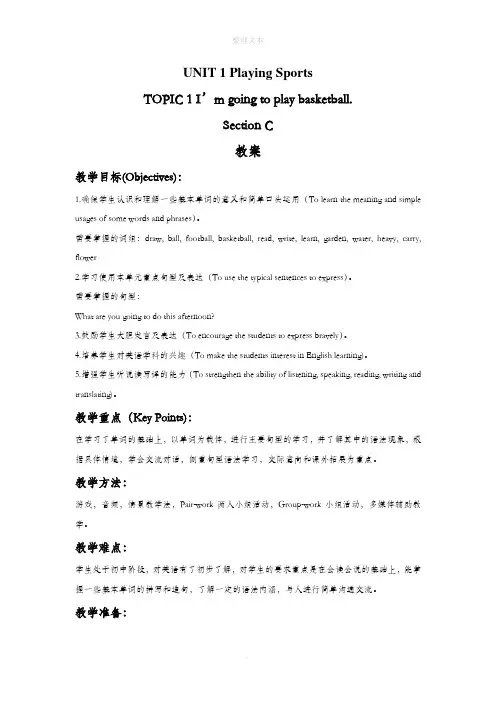
UNIT 1 Playing SportsTOPIC 1 I’m going to play basketball.Section C教案教学目标(Objectives):1.确保学生认识和理解一些基本单词的意义和简单口头运用(To learn the meaning and simple usages of some words and phrases)。
需要掌握的词组:draw, ball, football, basketball, read, write, learn, garden, water, heavy, carry, flower2.学习使用本单元重点句型及表达(To use the typical sentences to express)。
需要掌握的句型:What are you going to do this afternoon?3.鼓励学生大胆发言及表达(To encourage the students to express bravely)。
4.培养学生对英语学科的兴趣(To make the students interest in English learning)。
5.增强学生听说读写译的能力(To strengthen the ability of listening, speaking, reading, writing and translating)。
教学重点(Key Points):在学习了单词的基础上,以单词为载体,进行主要句型的学习,并了解其中的语法现象,根据具体情境,学会交流对话,侧重句型语法学习,交际意向和课外拓展为重点。
教学方法:游戏,音频,情景教学法,Pair-work两人小组活动,Group-work小组活动,多媒体辅助教学。
教学难点:学生处于初中阶段,对英语有了初步了解,对学生的要求重点是在会读会说的基础上,能掌握一些基本单词的拼写和造句,了解一定的语法内涵,与人进行简单沟通交流。
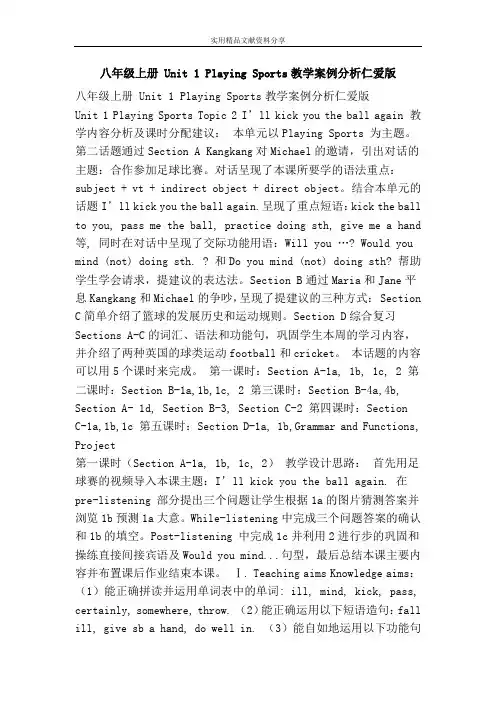
八年级上册 Unit 1 Playing Sports教学案例分析仁爱版八年级上册 Unit 1 Playing Sports教学案例分析仁爱版Unit 1 Playing Sports Topic 2 I’ll kick you the ball again 教学内容分析及课时分配建议:本单元以Playing Sports 为主题。
第二话题通过Section A Kangkang对Michael的邀请,引出对话的主题:合作参加足球比赛。
对话呈现了本课所要学的语法重点:subject + vt + indirect object + direct object。
结合本单元的话题I’ll kick you the ball again.呈现了重点短语:kick the ball to you, pass me the ball, practice doing sth, give me a hand 等, 同时在对话中呈现了交际功能用语:Will you …? Would you mind (not) doing sth. ? 和Do you mind (not) doing sth? 帮助学生学会请求,提建议的表达法。
Section B通过Maria和Jane平息Kangkang和Michael的争吵,呈现了提建议的三种方式: Section C简单介绍了篮球的发展历史和运动规则。
Section D综合复习Sections A-C的词汇、语法和功能句,巩固学生本周的学习内容,并介绍了两种英国的球类运动football和cricket。
本话题的内容可以用5个课时来完成。
第一课时:Section A-1a, 1b, 1c, 2 第二课时:Section B-1a,1b,1c, 2 第三课时:Section B-4a,4b, Section A- 1d, Section B-3, Section C-2 第四课时:SectionC-1a,1b,1c 第五课时:Section D-1a, 1b,Grammar and Functions, Project第一课时(Section A-1a, 1b, 1c, 2)教学设计思路:首先用足球赛的视频导入本课主题:I’ll kick you the ball again. 在pre-listening 部分提出三个问题让学生根据1a的图片猜测答案并浏览1b预测1a大意。
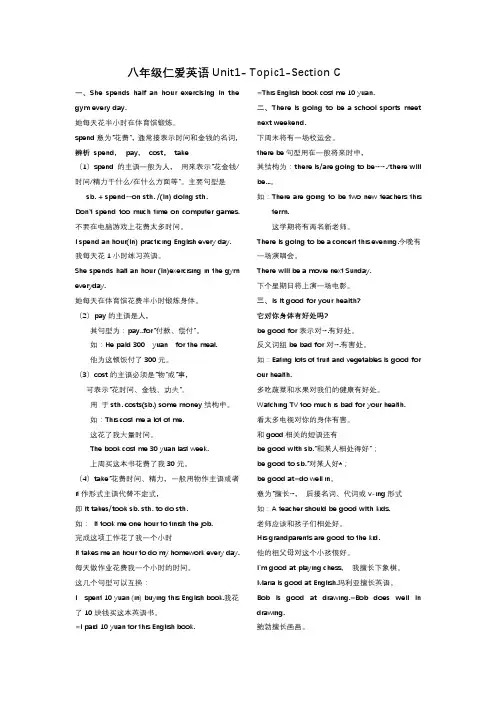
八年级仁爱英语Unit1- Topic1-Section C一、She spends half an hour exercising in the gym every day.她每天花半小时在体育馆锻炼。
spend意为“花费”,通常接表示时间和金钱的名词,辨析spend,pay,cost,take(1)spend的主语一般为人,用来表示“花金钱/时间/精力干什么/在什么方面等”。
主要句型是sb. + spend…on sth. /(in) doing sth. Don’t spend too much time on computer games. 不要在电脑游戏上花费太多时间。
I spend an hour(in)practicing English every day.我每天花1小时练习英语。
She spends half an hour (in)exercising in the gym everyday.她每天在体育馆花费半小时锻炼身体。
(2)pay的主语是人,其句型为:pay..for“付款、偿付”。
如:He paid 300 yuan for the meal.他为这顿饭付了300元。
(3)cost的主语必须是“物”或“事,可表示“花时间、金钱、功夫”。
用于sth. costs(sb.) some money结构中。
如:This cost me a lot of me.这花了我大量时间。
The book cost me 30 yuan last week.上周买这本书花费了我30元。
(4)take“花费时间、精力,一般用物作主语或者it作形式主语代替不定式,即it takes/took sb. sth. to do sth.如:It took me one hour to finish the job.完成这项工作花了我一个小时It takes me an hour to do my homework every day.每天做作业花费我一个小时的时间。
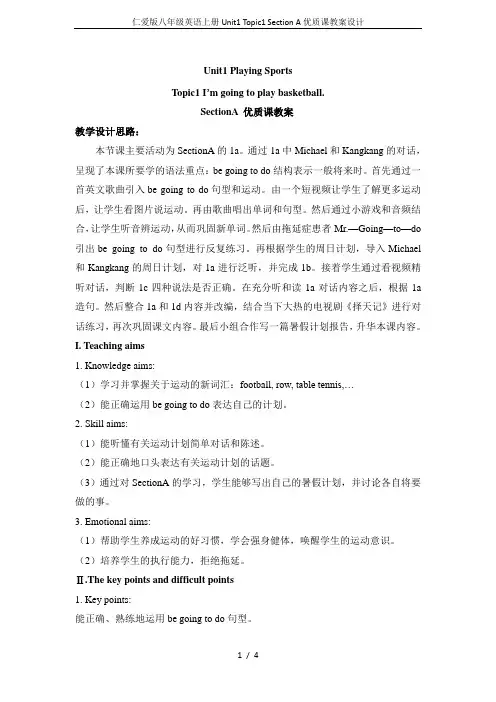
Unit1 Playing SportsTopic1 I’m going to play basketball.SectionA 优质课教案教学设计思路:本节课主要活动为SectionA的1a。
通过1a中Michael和Kangkang的对话,呈现了本课所要学的语法重点:be going to do结构表示一般将来时。
首先通过一首英文歌曲引入be going to do句型和运动。
由一个短视频让学生了解更多运动后,让学生看图片说运动。
再由歌曲唱出单词和句型。
然后通过小游戏和音频结合,让学生听音辨运动,从而巩固新单词。
然后由拖延症患者Mr.—Going—to—do 引出be going to do句型进行反复练习。
再根据学生的周日计划,导入Michael 和Kangkang的周日计划,对1a进行泛听,并完成1b。
接着学生通过看视频精听对话,判断1c四种说法是否正确。
在充分听和读1a对话内容之后,根据1a 造句。
然后整合1a和1d内容并改编,结合当下大热的电视剧《择天记》进行对话练习,再次巩固课文内容。
最后小组合作写一篇暑假计划报告,升华本课内容。
I. Teaching aims1. Knowledge aims:(1)学习并掌握关于运动的新词汇:football, row, table tennis,…(2)能正确运用be going to do表达自己的计划。
2. Skill aims:(1)能听懂有关运动计划简单对话和陈述。
(2)能正确地口头表达有关运动计划的话题。
(3)通过对SectionA的学习,学生能够写出自己的暑假计划,并讨论各自将要做的事。
3. Emotional aims:(1)帮助学生养成运动的好习惯,学会强身健体,唤醒学生的运动意识。
(2)培养学生的执行能力,拒绝拖延。
Ⅱ.The key points and difficult points1. Key points:能正确、熟练地运用be going to do句型。
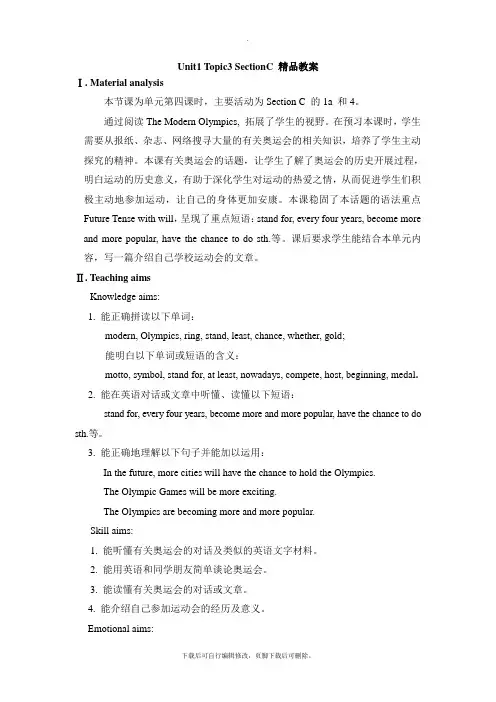
Unit1 Topic3 SectionC 精品教案Ⅰ. Material analysis本节课为单元第四课时,主要活动为Section C 的1a 和4。
通过阅读The Modern Olympics, 拓展了学生的视野。
在预习本课时,学生需要从报纸、杂志、网络搜寻大量的有关奥运会的相关知识,培养了学生主动探究的精神。
本课有关奥运会的话题,让学生了解了奥运会的历史开展过程,明白运动的历史意义,有助于深化学生对运动的热爱之情,从而促进学生们积极主动地参加运动,让自己的身体更加安康。
本课稳固了本话题的语法重点Future Tense with will,呈现了重点短语:stand for, every four years, become more and more popular, have the chance to do sth.等。
课后要求学生能结合本单元内容,写一篇介绍自己学校运动会的文章。
Ⅱ. Teaching aimsKnowledge aims:1. 能正确拼读以下单词:modern, Olympics, ring, stand, least, chance, whether, gold;能明白以下单词或短语的含义:motto, symbol, stand for, at least, nowadays, compete, host, beginning, medal.2. 能在英语对话或文章中听懂、读懂以下短语:stand for, every four years, become more and more popular, have the chance to do sth.等。
3. 能正确地理解以下句子并能加以运用:In the future, more cities will have the chance to hold the Olympics.The Olympic Games will be more exciting.The Olympics are becoming more and more popular.Skill aims:1. 能听懂有关奥运会的对话及类似的英语文字材料。
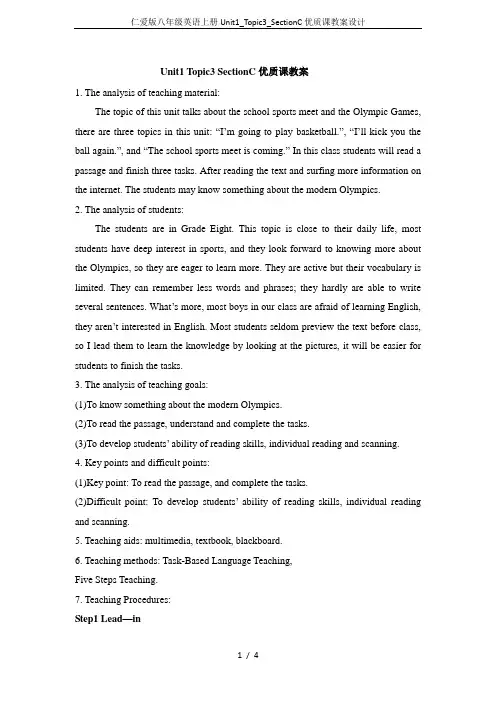
Unit1 Topic3 SectionC优质课教案1. The analysis of teaching material:The topic of this unit talks about the school sports meet and the Olympic Games, there are three topics in this unit: “I’m going to play basketball.”, “I’ll kick you the ball again.”, and “The school sports meet is coming.” In this class students will read a passage and finish three tasks. After reading the text and surfing more information on the internet. The students may know something about the modern Olympics.2. The analysis of students:The students are in Grade Eight. This topic is close to their daily life, most students have deep interest in sports, and they look forward to knowing more about the Olympics, so they are eager to learn more. They are active but their vocabulary is limited. They can remember less words and phrases; they hardly are able to write several sentences. What’s more, most boys in our class are afraid of learning English, they aren’t interested in English. Most students seldom preview the text before class, so I lead them to learn the knowledge by looking at the pictures, it will be easier for students to finish the tasks.3. The analysis of teaching goals:(1)To know something about the modern Olympics.(2)To read the passage, understand and complete the tasks.(3)To develop students’ ability of reading skills, individual reading and scanning.4. Key points and difficult points:(1)Key point: To read the passage, and complete the tasks.(2)Difficult point: To develop students’ ability of reading skills, individual reading and scanning.5. Teaching aids: multimedia, textbook, blackboard.6. Teaching methods: Task-Based Language Teaching,Five Steps Teaching.7. Teaching Procedures:Step1 Lead—inLet’s enjoy a song: Pass the flame.The teacher asks students: Do you like this song? And do you know what the song is about?Pass the flame is the theme song of the Olympic Games in Athens in 2004. Do you want to know more about the Olympics?Step2 Presentation (pre—reading)Teacher shows some pictures about the modern Olympics on the PPT, let students find out the years and the host cities. They should learn to say these sentences:The modern Olympics started in Athens, Greece in______.In 2000 ______ held the 27th Olympic Games.In 2004______ hosted the28th Olympic Games.______ hosted the 29th Olympic Games in 2008.London held the 30th Olympics in______.The 31st Olympics was held in ______ in2016.Then ask them to think about the two questions:Do you know when the next Olympics will be held?Which city will host the next Olympic Games?Activity 1: Match the years with the host cities of the Olympic Games.2000 Rio2004 London2008 Beijing2012 Athens2016 SydneyNext we will learn: the symbol of the Olympics and what do the five rings stand for? Olympic motto is: Faster, Higher, Stronger!Step3 Practice (while—reading)Task 1: Read the passage 1a and choose the correct answers.( ) 1. The modern Olympics started in______.A. 1952B. 1896C. 1996D. 2000( ) 2. What is the symbol of the Olympic Games?A. The Olympic emblems(会徽)B. The Olympic mascots (吉祥物)C. The Olympic ringsD. The flag of each country( ) 3. What do the five rings stand for?A. Five parts of the worldB. Five countriesC. Five citiesD. Five colors( ) 4. The Olympic Games are held every ______ years.A. 2B. 3C. 4D. 5( ) 5. Which of the following is TRUE?A. You can find one color in the flag of each country.B. The players from all over the world meet to compete and they can’t be friends.C. Only in Athens the Olympic motto is “Faster, Higher, and Stronger.”D. The Olympic Games will be more and more popular and exciting.While students doing this part, the teacher writes down the key words and phrase on the black board, after finishing the task, teacher retells the passage according to these tips.Task 2: Retell the passageThe modern Olympics started in Athens, Greece in ______. Its motto is “Faster, ______, Stronger”. The Olympic rings are a ______ of the Olympic Games. There are five rings, and they______ (代表)the five parts of the world. The ______ and Winter Olympics are held every four years. Nowadays, different cities hold the Olympics Games______(轮流). The Olympics are becoming______(越来越.......)popular and exciting.Step4 Summary: complete the notes (post—reading)1. The year of the first modern Olympics: __________________________________.2. The host city of the first modem Olympics:_________________________________.3. The motto of the Olympics Games:_______________________________________.4. The symbol of the Olympics Games:______________________________________.6. The colors of the rings:________________________________________________.7. The Summer Olympic Games are held every______ years.Step5 Homework1. Read this passage aloud.2. Finish part 2, 3 on page 228. Blackboard designTopic 3 The school sports meet is coming. (Section C)The modern OlympicsStarted in: 1896Stand for: the five parts of the worldBe held: every four yearsIn the future: more and more excitingThe Olympic motto: Faster, Higher, Stronger!9. Teaching reflectionIn this class, I think there are three successful points:(1) Listen to a song to attract students’ interest.(2) Lead students to learn more by reading other materials.(3) I integrate the textbook effectively that can make students understand easily. But there is also shortcoming, I pay less attention to individual students, focus on their learning results.I believe I will do better after my hard work.。
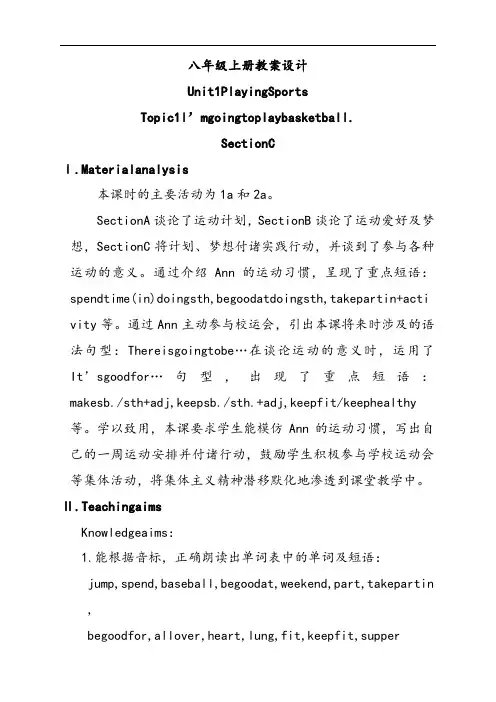
八年级上册教案设计Unit1PlayingSportsTopic1I’mgoingtoplaybasketball.SectionCⅠ.Materialanalysis本课时的主要活动为1a和2a。
SectionA谈论了运动计划,SectionB谈论了运动爱好及梦想,SectionC将计划、梦想付诸实践行动,并谈到了参与各种运动的意义。
通过介绍Ann的运动习惯,呈现了重点短语:spendtime(in)doingsth,begoodatdoingsth,takepartin+acti vity等。
通过Ann主动参与校运会,引出本课将来时涉及的语法句型:Thereisgoingtobe…在谈论运动的意义时,运用了It’sgoodfor…句型,出现了重点短语:makesb./sth+adj,keepsb./sth.+adj,keepfit/keephealthy 等。
学以致用,本课要求学生能模仿Ann的运动习惯,写出自己的一周运动安排并付诸行动,鼓励学生积极参与学校运动会等集体活动,将集体主义精神潜移默化地渗透到课堂教学中。
Ⅱ.TeachingaimsKnowledgeaims:1.能根据音标,正确朗读出单词表中的单词及短语:jump,spend,baseball,begoodat,weekend,part,takepartin ,begoodfor,allover,heart,lung,fit,keepfit,supper2.能在老师的引导下,分音节读出多音节单词或一些读音较难的短语:exercise,world,thedayaftertomorrow,healthy,relax3.能正确拼读并运用单词表中黑体单词。
4.能准确把握单数第三人称做主语时谓语的变化形式,并能谈论他人的运动爱好和梦想以及一周运动安排。
5.能模仿本课课文,写出自己或他人一周的体育活动安排。
Skillaims:1.能听懂本课文本材料以及与运动相关的交际用语。
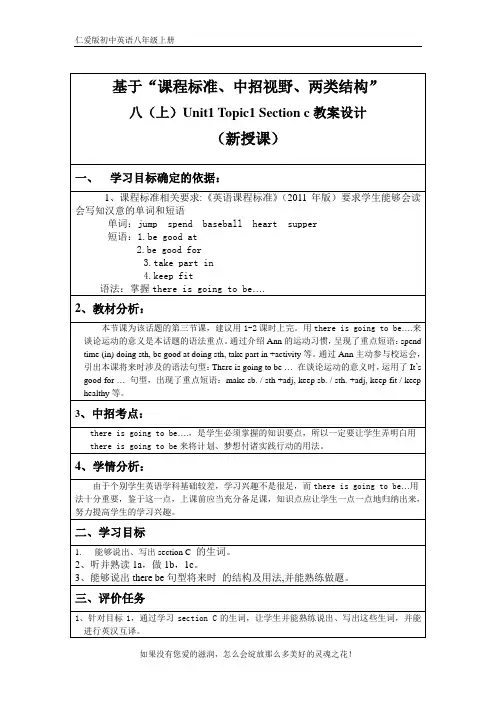
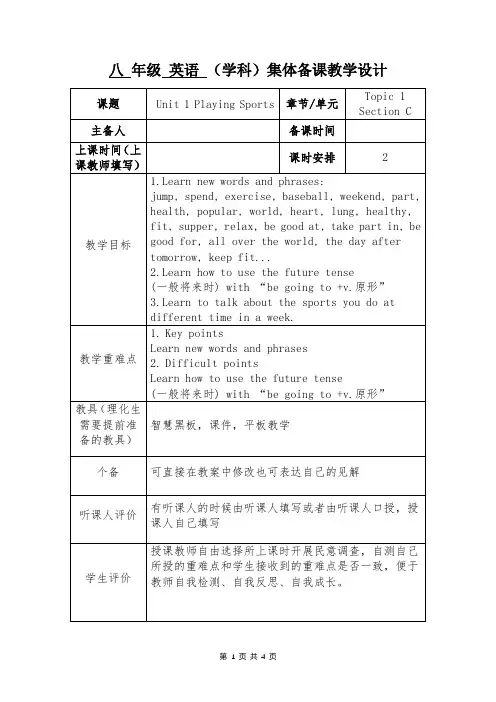
八年级英语(学科)集体备课教学设计【教学过程】Step 1 Pre-reading1.Review some sportsStep 2 While-readingTask1. Fast reading,then find out the topic sentence.Task 2. Read 1a and answer the questions .Task 3. Read 1a again and write the key phrases under each picture.Step 3 Post- reading1.Underline some key phrases and sentences2.Key points①go mountain climbing 去爬山。
go+v-ing形式的短语很多,在这类短语中,v-ing表示go的目的,意为“去做某事”。
②辨析spend, pay, cost, takespend 的主语一般为人,用来表示“花金钱/时间/精力干什么/在什么方面等” 。
主要句型是sb. + spend ... on sth./(in) doing sth.pay的主语是人,其句型为:pay ...for “付款”,“偿付”。
如:He paid 300 yuan for the meal.cost 主语为物,可表示“花时间,金钱,功夫”。
如:Theschoolbag cost me 68 yuan.take “花时间,精力“,一般用物作主语或者it做形式主语代替不定式,即It takes/took sb. sth. to do sth.。
如:It took me one hour to finish the job.③exercise.(作为不可数名词)意为“锻炼,运动”。
e.g. 运动使我们强壮。
Exercise makes us strong.(作为可数名词)意为“体操,练习,功课”。
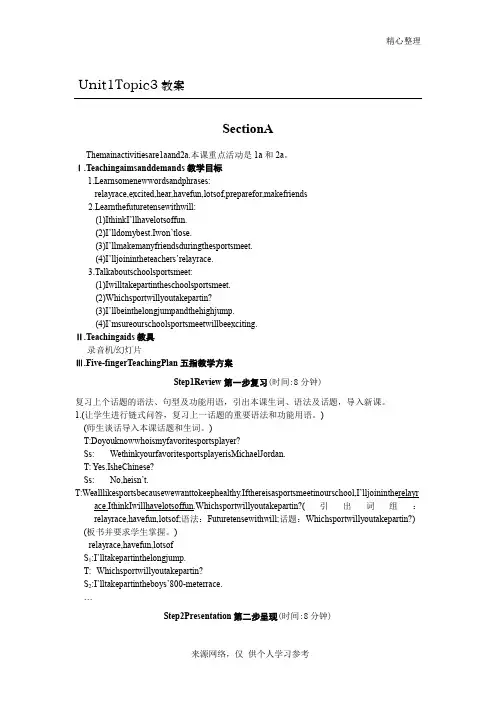
精心整理Unit1Topic3教案SectionAThemainactivitiesare1aand2a.本课重点活动是1a和2a。
Ⅰ.Teachingaimsanddemands教学目标1.Learnsomenewwordsandphrases:relayrace,excited,hear,havefun,lotsof,preparefor,makefriends2.Learnthefuturetensewith will:(1)Ithink I’llhavelotsoffun.(2)I’lldomybest.Iwon’tlose.(3)I’llmakemanyfriendsduringthesportsmeet.(4)I’lljoinintheteachers’relayrace.3.Talkaboutschoolsportsmeet:(1)Iwilltakepartintheschoolsportsmeet.(2)Whichsportwillyoutakepartin?(3)I’llbeinthelongjumpandthehighjump.(4)I’msureourschoolsportsmeetwillbeexciting.Ⅱ.Teachingaids教具录音机/幻灯片Ⅲ.Five-fingerTeachingPlan五指教学方案Step1Review第一步复习(时间:8分钟)复习上个话题的语法、句型及功能用语,引出本课生词、语法及话题,导入新课。
1.(让学生进行链式问答,复习上一话题的重要语法和功能用语。
)(师生谈话导入本课话题和生词。
)T:Doyouknowwhoismyfavoritesportsplayer?Ss: WethinkyourfavoritesportsplayerisMichaelJordan.T: Yes.IsheChinese?Ss: No,heisn’t.T:Wealllikesportsbecausewewanttokeephealthy.Ifthereisasportsmeetinourschool,I’lljoinintherelayr ace.IthinkIwillhavelotsoffun.Whichsportwillyoutakepartin?(引出词组:relayrace,havefun,lotsof;语法:Futuretensewith will;话题:Whichsportwillyoutakepartin?) (板书并要求学生掌握。
仁爱英语+八年级上+unit+1+topic+1+section+c+教学反思摘要:一、引言1.教学反思背景2.学生英语学习现状二、教学过程反思1.教学目标明确2.教学方法及策略2.1 课堂活动设计2.2 学生参与程度2.3 语言输入与输出三、教学效果反思1.学生学习成果评估2.学生反馈与建议四、问题与改进措施1.教学过程中遇到的问题2.针对问题的改进方案五、总结与展望1.教学反思总结2.未来教学计划与期望正文:作为一名英语教师,我一直在反思和改进我的教学方法,以期提高学生的学习兴趣和实际英语运用能力。
在此,我将针对仁爱英语八年级上Unit 1 Topic 1 Section C的教学进行反思。
一、引言随着教育理念的不断更新,我们的教学方式也在发生变化。
在新课程改革的背景下,我开始尝试采用更符合学生实际需求和兴趣的教学方法。
然而,在实践中,我发现学生们在英语学习方面仍存在一定的问题。
为了进一步提高教学质量,我对Unit 1 T opic 1 Section C 的教学进行了反思。
二、教学过程反思1.教学目标明确在教学前,我明确了本节课的教学目标,即让学生掌握重点词汇、句型和语法结构,并能运用所学知识进行实际交流。
在教学过程中,我围绕这一目标展开教学,确保学生能够达到预期学习效果。
2.教学方法及策略为了提高学生的学习兴趣和参与度,我设计了多种形式的课堂活动。
如:小组讨论、角色扮演、互动游戏等。
在课堂活动中,我发现学生们积极参与,课堂氛围较为活跃。
但在部分环节,仍有学生因自信心不足而参与度不高。
2.1 课堂活动设计在课堂活动设计方面,我应更加注重学生的实际需求,关注个体差异,给予每个学生充分展示自己的机会。
2.2 学生参与程度为了提高学生的参与度,我将在今后的教学中尝试采用多样化的教学手段,如:多媒体课件、实物展示等,激发学生的学习兴趣。
同时,关注学生的情感需求,给予鼓励和表扬,增强学生的自信心。
2.3 语言输入与输出在课堂教学中,我注重学生的语言输入与输出。
Unit1 Playing SportsTopic 1 I’m going to play basketball.SectionC 优质课教案I. Teaching aims1. To learn some useful words and expressions:Taekwondo/table tennis/badminton/go cycling/go unicycling/spend/take part in/be good at...2. To learn the Simple Future Tense with “be going to”:3. To talk about the favorite sports.Ⅱ.Key and Difficult PointsKey points:1. some phrases about sports2. some important expressions: spend.in doing/on..…, take part in…, There is going to be...Difficult points:1. spend time(in)doing sth./spend time on sth.;2. There is going to be...Ⅲ.Teaching proceduresStep1 Warm—upPlay the video about sportsT: What sports can you find in this video?S: Soccer/basketball /swim/run.Step2 Pre-reading1. Ask and answerT: Do you like them? What’s your favorite sport?S1: My favorite sport is basketball.T: When do you often play basketball?S1: On Sundays.T: S2, please talk about S1 according to what he said.S2: He likes sports very much. He often plays basketball on Sundays.(Ask another student)T: S3, do you like doing exercise?S3: Yes. I do.T: How often do you do exercise?S3: Every day.T: How long do you spend every day?S3: Twenty or thirty minutes.T: S4 please talk about S3 according to what he said.S4: He/She likes exercising. He/She often spends twenty or thirty minutes exercising every day.T: Thirty minutes is half an hour.E.g. swimming/cycling/playing table tennis/badminton/basketball/soccer/riding a unicycle.How often do you do it?I play basketball/soccer/badminton /table tennis twice a week.I run three times a week.I go cycling twice a week.I often go swimming on Sundays.I spent half an hour playing basketball every day.2. Pair—work: I will give you two minutes. Please do a survey, ask your partner these questions and then report the information about him/her. (Begins with He/She likes.)T: Time’s up, which pair wants to have a try?S1: Jack likes playing basketball very much. He spends half an hour playing basketball every day.S2: Tina likes swimming. She goes swimming once a week. And she often swims on Sundays.Step3 While—reading。
Unit1 Topic2 SectionC 参考教案Ⅰ. Material analysis本节课主要活动为1a 和2。
1a 简单介绍了篮球形成的原因、经过及打篮球基本规则,让学生了解了打篮球的历史意义,教育学生要热爱篮球运动,传承历史文化。
2 通过近义句的学习丰富了学生的语言积累,避免单一的表达。
课后要求学生写一篇有关篮球运动的文章,旨在将热爱运动的思想耕织于学生心中。
Ⅱ. Teaching aimsKnowledge aims:1. 能根据音标,正确朗读出单词表中单词及短语。
2. 能正确拼读并运用单词。
3. 能运用can, can’t , must, should 等情态动词提建议。
如:You can throw it from any part of the court.You must follow the rules.You can’t hold the ball and run with it.You should have good skills.4. 能正确使用以下短语,复述本课课文,简单地介绍篮球运动。
invent sth, come into being, stop…from doing sth, follow the rules, enjoy doing sthSkill aims:1. 能听懂本课文本材料以及与篮球运动相关的课堂用语。
2. 能熟练地口头谈论有关篮球的历史,规则及意义的话题。
3. 能准确朗读课本的文本材料,并能正确地朗读相关的文本材料。
4. 能规范地模仿本课课文,写出有关篮球运动的文章。
Emotional aims:教育学生要热爱篮球运动,体现合作精神,突出团队协作的重要性。
Ⅲ. The key points and difficult pointsKey points:invent sth, come into being, stop…from doing sth, follow the rules, enjoy doingsth 的运用。
八年级上册教案设计Unit1PlayingSportsTopic2I’llkickyoutheballagain.SectionCⅠ.Materialanalysis本节课的主要活动为1a和2。
1a简单介绍了篮球形成的原因、经过及打篮球基本规则,让学生了解了打篮球的历史意义,教育学生要热爱篮球运动,传承历史文化。
2通过近义句的学习丰富了学生的语言积累,避免单一的表达。
课后要求学生写一篇有关篮球运动的文章,旨在将热爱运动的思想耕织于学生心中。
Ⅱ.TeachingaimsKnowledgeaims:1.能根据音标,正确朗读出单词表中单词及短语。
2.能正确拼读并运用单词。
3.能运用can,can’t,must,should等情态动词提建议。
如:Youcanthrowitfromanypartofthecourt.Youmustfollowtherules.Youcan’tholdtheballandrunwithit.Youshouldhavegoodskills.4.能正确使用以下短语,复述本课课文,简单地介绍篮球运动。
inventsth,comeintobeing,stop…fromdoingsth,followtherules,enjoydoingsthSkillaims:1.能听懂本课文本材料以及与篮球运动相关的课堂用语。
2.能熟练地口头谈论有关篮球的历史,规则及意义的话题。
3.能准确朗读课本的文本材料,并能正确地朗读相关的文本材料。
4.能规范地模仿本课课文,写出有关篮球运动的文章。
Emotionalaims:教育学生要热爱篮球运动,体现合作精神,突出团队协作的重要性。
Ⅲ.ThekeypointsanddifficultpointsKeypoints:inventsth,comeintobeing,stop…fromdoingsth,followthe rules,enjoydoingsth的运用。
Unit1 Topic3 Section C 优质课教案(湖南省)一、教学目标(1)knowledge objects: talk about Olympics, students are expected to learn the use will/shall structure.(2)ability objects: students are encouraged to use some methods of reading skills to get a better understanding of the who le text.(3)moral objects Students are expected to feel more proud of being Chinese and study hard to realize the Olympic dreams.二、学情分析1.This unit mainly talks about sports. Section C is focused on the modernOlympics and introduces the Modern Olympics in detail. It is interesting andfamiliar for students. There are not so many new words or phrases in the passage.Students may feel more proud of being Chinese after learning the passage.三、重点难点(1)apply the reading strategy-skimming to find the main idea without reading every word.(2)get the general ide a or specific information by using reading skills like scanning and extensive reading.四、教学过程4.1第一学时Step1Wam-up and Lead-in4.1.1教学活动活动1【活动】pre-readingAsk students to find out more information about the Olympics before the class, have a quick-response game by setting different questions like. The father ofOlympics is? the mascots of Beijing Olympics are? the motto of Beijing Olympics is? and so on. Students should speak out the answers as quickly as possible.活动2【活动】while-reading1. Skimming Give students 30 seconds to look through the passage and answer thequestion: Is the Olympics are becoming more and more popular?2. Scanning Give students five sentences to choose(T)or(F)and correct themistakes. 3. Extensive readingparagraph 1: play the tape for students, ask them to fill in the table.Paragraph 2: Ask one student to read it and others to fill in the blanks. Paragraph 3: boys and girls will have a competition. Read the paragraph 3 and try to set questions by themselves.活动3【活动】explanationExplain the key sentences and phrases for students. Get them to know the usage of phrases and encourage them to do some translation exercises about thelanguage points. The student who translates the sentence correctly can get amedal for his/her group.活动4【活动】post-reading1. Play the tape recorder. Let the students listen and imitate the passage. Payattention to the pronunciation and intonation.2. Give the students two or three minutes to prepare to retell the story accordingto the key word ne paragraph by one paragraph. Encourage them to retell it aloud.3. The teacher can lead in the next task by saying like this: We are Chinese, we areproud of our country. We all have our own Olympic dream. As students, whatwill we do to realize our Olympic dreams.? Then the teacher divides the whole class into five or six groups. ask them the discuss with the partners by asking“what will you do to realize your Olympic dream?” After preparing, each group asks a student to present the information of his/her group.活动5【活动】summary and moral educationOlympic Spirit is in every corner of the world. show the pictures and the famous saying of Olympics: The important thing in the Olympic Games is not winning, but taking part. The essential thing in life s not conquering, but fighting well.。
仁爱版八年级上册Unit 1 Playing Sports Topic 1 I’m going to play
basketball. Section C 教学设计
Ⅰ. Material analysis
本节课为本单元第四课时,主要活动为1a和2a。
Section A谈论了运动计划,Section B 谈论了运动爱好及梦想,Section C 将计划、梦想付诸实践行动,并谈到了参与各种运动的意义。
通过介绍Ann的运动习惯,呈现了重点短语:spend time (in) doing sth, be good at doing sth, take part in +activity等。
通过Ann主动参与校运会,引出本课将来时涉及的语法句型:There is going to be …在谈论运动的意义时,运用了It’s good for …句型,出现了重点短语:make sb. / sth +adj, keep sb. / sth. +adj, keep fit / keep healthy等。
学以致用,本课要求学生能模仿Ann的运动习惯,写出自己的一周运动安排并付诸行动,鼓励学生积极参与学校运动会等集体活动,将集体主义精神潜移默化地渗透到课堂教学中。
Ⅱ. Teaching aims
Knowledge aims:
1. 能根据音标,正确朗读出单词表中的单词及短语:
jump, spend, baseball, be good at, weekend, part, take part in,
be good for, all over, heart, lung, fit , keep fit, supper
2. 能在老师的引导下,分音节读出多音节单词或一些读音较难的短语:
exercise, world, the day after tomorrow, healthy, relax
3. 能正确拼读并运用单词表中黑体单词。
4. 能准确把握单数第三人称做主语时谓语的变化形式,并能谈论他人的运动爱好和梦想以及一周运动安排。
5. 能模仿本课课文,写出自己或他人一周的体育活动安排。
Skill aims:
1. 能听懂本课文本材料以及与运动相关的交际用语。
2. 能正确地口头介绍自己和他人平时的运动安排。
3. 能正确朗读课本的文本材料,准确把握语音、语调及连读,并能读相关的材料。
4. 能正确模仿本课课文,写出自己或他人一周日常的体育活动安排。
Emotional aims:
学生能模仿课文写出自己的一周体育活动安排并付诸行动,鼓励学生要学习Ann, 养成健康而规律的生活习惯。
Ⅲ. The key points and difficult points
Key points:
1. 有关体育活动及户外活动的短语。
2. 重点短语的用法,如:spend …in/on …, take part in …, There is going to be …
Difficult points:
1. spend time (in) doing sth./ spend time on sth.;
2. make / keep sb./ sth. + adj ;
3. the differences between “health”and “healthy”;
4. There is going to be …。